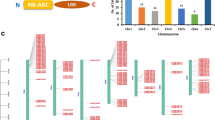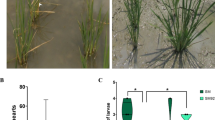Abstract
The class of nucleotide-binding site (NBS)-Leucine-rich repeat (LRR) disease resistance genes play an important role in defending plants from a variety of pathogens and insect pests. Consequently, many NBS-LRR genes have been identified in various plant species. In this study, we identified 617 NBS-encoding genes in the Medicago truncatula genome (Mt3.5v5) and divided them into two groups, regular (490) and non-regular (127) NBS-LRR genes. The regular NBS-LRR genes were characterized on the bases of structural diversity, chromosomal location, gene duplication, conserved protein motifs, and EST expression profiling. According to N-terminal motifs and LRR motifs, the 490 regular NBS-LRR genes were then classified into 10 types: CC-NBS (4), CC-NBS-LRR (212), TIR-NBS (20), TIR-NBS-LRR (160), TIR-NBS-TIR (1), TIR-NBS-TIR-LRR (2), NBS-TIR (7), NBS-TIR-LRR (1), NBS (10), and NBS-LRR (73). Analysis of the physical location and duplications of the regular NBS-LRR genes revealed that the M. truncatula genome is similar to rice. Interestingly, we found that TIR-type genes are more frequently expressed than non-TIR-type genes in M. truncatula, whereas the number of non-TIR-type regular NBS-LRR genes was greater than TIR-type genes, suggesting the gene expression was not associated with the total number of NBS-LRR genes. Moreover, we found that the phylogenetic tree supported our division of the regular NBS-LRR genes into two distinct clades (TIR-type and non-TIR-type), but some of the non-TIR-type lineages contain TIR-type genes. These analyses provide a robust database of NBS-LRR genes in M. truncatula that will facilitate the isolation of new resistance genes and breeding strategies to engineer disease resistance in leguminous crop.



Similar content being viewed by others
References
Flor HH (1971) Current status of the gene-for-gene concept. Annu Rev Phytopathol 9:275–296
Dangl JL, Jones JD (2001) Plant pathogens and integrated defence responses to infection. Nature 411:826–833
Hammond-Kosack KE, Jones JDG (1997) Plant disease resistance genes. Annu Rev Plant Physiol Plant Mol Biol 48:575–607
Martin GB, Bogdanove AJ, Sessa G (2003) Understanding the functions of plant disease resistance proteins. Annu Rev Plant Biol 54:23–61
Staskawicz BJ, Mudgett MB, Dangl JL et al (2001) Common and contrasting themes of plant and animal diseases. Science 292:2285–2289
Jones JD, Dangl JL (2006) The plant immune system. Nature 444:323–329
McHale L, Tan X, Koehl P et al (2006) Plant NBS–LRR proteins: adaptable guards. Genome Biol 7:212
Dodds PN, Rathjen JP (2010) Plant immunity: towards an integrated view of plant–pathogen interactions. Nat Rev Genet 11:539–548
Gay NJ, Gangloff M (2007) Structure and function of Toll receptors and their ligands. Annu Rev Biochem 76:141–165
Meyers BC, Kozik A, Griego A et al (2003) Genome-wide analysis of NBS-LRR-encoding genes in Arabidopsis. Plant Cell 15:809–834
Mun JH, Yu HJ, Park S et al (2009) Genome-wide identification of NBS-encoding resistance genes in Brassica rapa. Mol Genet Genomics 282:617–631
Tameling WI, Elzinga SD, Darmin PS et al (2002) The tomato R gene products I-2 and MI-1 are functional ATP binding proteins with ATPase activity. Plant Cell 14:2929–2939
Tameling WI, Vossen JH, Albrecht M et al (2006) Mutations in the NB-ARC domain of I-2 that impair ATP hydrolysis cause autoactivation. Plant Physiol 140:1233–1245
Swiderski MR, Birker D, Jones JD (2009) The TIR domain of TIR-NB-LRR resistance proteins is a signaling domain involved in cell death induction. Mol Plant Microbe Interact 22:157–165
Krasileva KV, Dahlbeck D, Staskawicz BJ (2010) Activation of an Arabidopsis resistance protein is specified by the in planta association of its leucine-rich repeat domain with the cognate oomycete effector. Plant Cell 22:2444–2458
Maekawa T, Cheng W, Spiridon LN et al (2011) Coiled-coil domain-dependent homodimerization of intracellular barley immune receptors defines a minimal functional module for triggering cell death. Cell Host Microbe 9:187–199
Sayar-Turet M, Dreisigacker S, Braun HJ et al (2011) Genetic variation within and between winter wheat genotypes from Turkey, Kazakhstan, and Europe as determined by nucleotide-binding-site profiling. Genome 54:419–430
Belkhadir Y, Nimchuk Z, Hubert DA et al (2004) Arabidopsis RIN4 negatively regulates disease resistance mediated by RPS2 and RPM1 downstream or independent of the NDR1 signal modulator and is not required for the virulence functions of bacterial type III effectors AvrRpt2 or AvrRpm1. Plant Cell 16:2822–2835
Young ND, Debellé F, Oldroyd GE et al (2011) The Medicago genome provides insight into the evolution of rhizobial symbioses. Nature 480:520–524
Akita M, Valkonen JP (2002) A novel gene family in moss (Physcomitrella patens) shows sequence homology and a phylogenetic relationship with the TIR-NBS class of plant disease resistance genes. J Mol Evol 55:595–605
Meyers BC, Dickrman AW, Michelmore RW et al (1999) Plant disease resistance genes encode members of an ancient and diverse protein family within the nucleotide-binding superfamily. Plant J 20:317–332
Ameline-Torregrosa C, Wang BB, O’Bleness MS et al (2008) Identification and characterization of nucleotide-binding site-leucine-rich repeat genes in the model plant Medicago truncatula. Plant Physiol 146:5–21
Branca A, Paape TD, Zhou P et al (2011) Whole-genome nucleotide diversity, recombination, and linkage disequilibrium in the model legume Medicago truncatula. Proc Natl Acad Sci USA 108:E864–E870
Finn RD, Mistry J, Schuster-Böckler B et al (2006) Pfam:clan, web tools and services. Nucleic Acids Res 34:247–251
Zhou T, Wang Y, Chen JQ et al (2004) Genome-wide identification of NBS genes in japonica rice reveals significant expansion of divergent non-TIR NBS-LRR genes. Mol Genet Genomics 271:402–415
Berger B, Wilson DB, Wolf E et al (1995) Predicting coiled coils by use of pairwise residue correlations. Proc Natl Acad Sci USA 92:8259–8263
Thompson JD, Higgings DG, Gibson TJ (1994) CLUSTAL W: improving the sensitivity of progressive multiple sequence alignment through sequence weighting, position-specific gap penalties and weight matrix choice. Nucleic Acids Res 22:4673–4680
Bailey TL, Elkan C (1995) The value of prior knowledge in discovering motifs with MEME. Proc Int Conf Intell Syst Mol Biol 3:21–29
Zhao Y, Li X, Chen W et al (2011) Whole-genome survey and characterization of MADS-box gene family in maize and sorghum. Plant Cell Tiss Organ Cult 105:159–173
Letunic I, Doerks T, Bork P (2012) SMART 7: recent updates to the protein domain annotation resource. Nucleic Acids Res 40:302–305
Thompson JD, Gibson TJ, Plewniak F et al (1997) The CLUSTAL_X windows interface: flexible strategies for multiple sequence alignment aided by quality analysis tools. Nucleic Acids Res 25:4876–4882
Tamura K, Dudley J, Nei M et al (2007) MEGA4: molecular evolutionary genetics analysis (MEGA) software version 4.0. Mol Biol Evol 24:1596–1599
Li X, Cheng Y, Ma W et al (2010) Identification and characterization of NBS-encoding disease resistance genes in Lotus japonicus. Plant Syst Evol 289:101–110
Cheng Y, Li X, Jiang H et al (2012) Systematic analysis and comparison of nucleotide-binding site disease resistance genes in maize. FEBS J 279:2431–2443
Pan Q, Wendel J, Fluhr R (2000) Divergent evolution of plant NBS-LRR resistance gene homologues in dicot and cereal genomes. J Mol Evol 50:203–213
Meyers BC, Morgante M, Michelmore RW (2002) TIR-X and TIR-NBS proteins: two new families related to disease resistance TIR-NBS-LRR proteins encoded in Arabidopsis and other plant genomes. Plant J 32:77–92
Tan S, Wu S (2012) Genome wide analysis of nucleotide-binding site disease resistance genes in Brachypodium distachyon. Comp Funct Genomics 2012:418208
Kohler A, Rinaldi C, Duplessis S et al (2008) Genome-wide identification of NBS resistance genes in Populus trichocarpa. Plant Mol Biol 66:619–636
Li L, Stoeckert CJ Jr, Roos DS (2003) OrthoMCL: identification of ortholog groups for eukaryotic genomes. Genome Res 13:2178–2189
Holub EB (2001) The arms race is ancient history in Arabidopsis, the wildflower. Nat Rev Genet 2:516–527
Ohlrogge J, Benning C (2000) Unraveling plant metabolism by EST analysis. Curr Opin Plant Biol 3:224–228
Bai J, Pennill LA, Ning J et al (2002) Diversity in nucleotide binding site-leucine-rich repeat genes in cereals. Genome Res 12:1871–1884
Monosi B, Wisser RJ, Pennill L et al (2004) Full-genome analysis of resistance gene homologues in rice. Theor Appl Genet 109:1434–1447
Yang S, Zhang X, Yue JX et al (2008) Recent duplications dominate NBS-encoding gene expansion in two woody species. Mol Genet Genomics 280:187–198
Zhang X, Feng Y, Cheng H et al (2011) Relative evolutionary rates of NBS-encoding genes revealed by soybean segmental duplication. Mol Genet Genomics 285:79–90
Luo S, Zhang Y, Hu Q et al (2012) Dynamic nucleotide-binding site and leucine-rich repeat-encoding genes in the grass family. Plant Physiol 159:197–210
Lozano R, Ponce O, Ramirez M et al (2012) Genome-wide identification and mapping of NBS-encoding resistance genes in Solanum tuberosum group phureja. PLoS ONE 7:e34775
Porter BW, Paidi M, Ming R et al (2009) Genome-wide analysis of Carica papaya reveals a small NBS resistance gene family. Mol Genet Genomics 281:609–626
Richly E, Kurth J, Leister D (2002) Mode of amplification and reorganization of resistance genes during recent Arabidopsis thaliana evolution. Mol Biol Evol 19:76–84
Yue JX, Meyers BC, Chen JQ et al (2012) Tracing the origin and evolutionary history of plant nucleotide-binding site-leucine-rich repeat (NBS-LRR) genes. New Phytol 193:1049–1063
Shen QH, Zhou F, Birei S et al (2003) Recognition specificity and RAR1/SGT1 dependence in barley Mla disease resistance genes to the powdery mildew fungus. Plant Cell 15:732–744
Rairdan GJ, Moffett P (2006) Distinct domains in the ARC region of the potato resistance protein Rx mediate LRR binding and inhibition of activation. Plant Cell 18:2082–2093
Nobuta K, Ashfield T, Kim S et al (2005) Diversification of non-TIR class NB-LRR genes in relation to whole-genome duplication events in Arabidopsis. Mol Plant Microbe Interact 18:103–109
Yu J, Wang J, Lin W et al (2005) The genomes of Oryza sativa: a history of duplications. PLoS Biol 3:e38
Tan X, Meyers BC, Kozik A et al (2007) Global expression analysis of nucleotide binding site-leucine rich repeat-encoding and related genes in Arabidopsis. BMC Plant Biol 7:56
Acknowledgments
This work was supported by the National Basic Research Program of China (2014CB138702). We thank members of the State Key Laboratory of Grassland Agro-ecosystems for their assistance in this study.
Author information
Authors and Affiliations
Corresponding author
Electronic supplementary material
Below is the link to the electronic supplementary material.
About this article
Cite this article
Song, H., Nan, Z. Genome-wide analysis of nucleotide-binding site disease resistance genes in Medicago truncatula . Chin. Sci. Bull. 59, 1129–1138 (2014). https://doi.org/10.1007/s11434-014-0155-3
Received:
Accepted:
Published:
Issue Date:
DOI: https://doi.org/10.1007/s11434-014-0155-3




